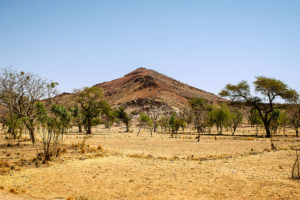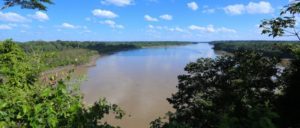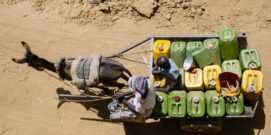
What does forest landscape restoration mean for tenure, governance and communities?
About 30 percent of the earth’s surface is covered by forests, and around 1.6 billion people depend on them for significant contributions to their environments and livelihoods. Yet, 12 million hectares of intact forests are lost in the tropics every year, either through permanent destruction or degradation.
Forest Landscape Restoration (FLR) is one of the newer initiatives to be put forward to help solve the problem. While its better-known cousin REDD+ aims to reduce emissions from deforestation and degradation, the goal of FLR is to restore ecological integrity to deforested and degraded landscapes. Both see the link between healthy forests and human wellbeing.
Interest in FLR increased in 2011, with the launch of the Bonn Challenge, which aims to restore 150 million ha of degraded land by 2020, a figure that the 2014 New York Declaration on Forests increased to 350 million ha by 2030.
Scientists from the Center for International Forestry Research (CIFOR), including those working as part of the CGIAR Research Program on Forests, Trees and Agroforestry (FTA) and CGIAR Research Program on Policies, Institutions, and Markets, are looking into how FLR is working so far, and aiming to identify key challenges. Some of these are laid out in a new paper highlighting tenure, governance and equity considerations for getting FLR to work on the ground.
“The international community has committed tremendous resources to reforesting areas of extensive forest loss in the tropics. Very ambitious goals have been set, but implementation in many countries has been slow,” notes Steven Lawry, Director of CIFOR’s Equity, Gender and Tenure research program, and a coauthor of the paper.
Lawry believes this is in part due to the fact that insufficient attention has been given to questions of the strength of land and forest rights held by people living in areas intended to benefit from restoration initiatives.
“In fact, community rights are often very weak. Communities are not able to make decisions about the planning or implementation of FLR projects,” says Lawry.
IS THIS LAND MY LAND?
The researchers found that tenure systems play a major role in shaping who benefits from forests and who benefits from restoration initiatives.
“Tenure security is vital,” says Lawry. “Communities or individuals with land and forest rights can make decisions about taking up FLR investments on terms acceptable to themselves.”
“With forest rights, they can negotiate questions about choice of tree species, forest land use in relation to other land uses, and operating principles about forest management and governance,” he adds.
The scientists found that one major obstacle to achieving this goal is that people may have rights to the land, but not to all trees on that land.
Read more: For secure land rights, indigenous forest communities need more than just titles

“FLR is about trying to restore ecological functionality and, generally speaking, native species tend to be better for that,” notes Rebecca McLain, CIFOR consultant and author of the paper.
“But if people don’t have rights to sustainably grow native species, the ones that are protected, then they aren’t going to grow those species in the areas they have ownership over because they aren’t their trees. So that’s a really big disincentive,” she says.
She points to Ghana, which has had some success in overcoming this challenge through a government-run revenue-sharing initiative known as Community Resource Management Area (CREMA). Under CREMA, communities are given the authority to manage resources for economic benefit, while being supported in efforts to conserve native biodiversity.
CREMA directly deals with trade-offs between conservation and development aims, and uses local knowledge to protect land and forests sustainably.
FILLING IN POLICY GAPS
Much of the forest domain in developing countries is owned by the state and managed by national and local forest agencies. Forest governance is largely based on a combination of formal and informal regulation of forest use by governments, companies, communities and other forest users.
“Rules and regulations often support important values and public policy goals, including conservation and biodiversity protection,” says Lawry.
“But when policies fail to take account of the economic and land-use goals of local users, regulations can have punitive effects, by denying or limiting opportunities for communities to derive livelihood benefits from forests, even for sustainable forest uses,” he adds.
McLain says another key issue that often came up was a “mismatch” between forest policies and agricultural policies.
“So you have a forest policy trying to support FLR and an agriculture policy which is encouraging people to clear land and plant crops. And those two end up being in conflict with each other,” says McLain.
Most people living in these forest communities are poor, so they will plant and harvest whatever provides them with the greatest income for their families. McLain says there are ways for people to make a living from the forest, but if they can make more from agriculture then they will likely clear the land for crops.
“At that point, you need to see a payments-for-ecosystem-services policy come in, where you literally pay people not to clear the forest for crops like oil palm or cassava,” she says.
DEVIL IS IN THE DETAILS
The researchers found that NGOs often play a major role in supporting communities that want to manage their forests.
“In Madagascar, the government claims ownership of forests, but they had a law that made it possible to create a community-managed forest,” McLain says. “An international NGO helped the community broker the contract with the forest service, and essentially they were then able to claim rights on a piece of land.”
Another solution the researchers say can work is giving long-term concessions to local communities rather than to big logging companies. Some countries are trying to do this by transferring rights to local communities, but often there is a qualifier.
“The deal is, if you want to harvest timber you need a management plan. Well, that’s not as easy as it sounds and it takes technical skills and time, so in essence, they were tying peoples’ hands,” says McLain.
Read more: Finding a way in for better landscape governance

Lawry agrees, adding that sophisticated management plans are needed in many contexts where communities have been given a measure of rights, not just concessions.
“The Kenyan provision for establishment of Community Forest Associations is a case in point. Communities can only use the forest once a management plan has been approved,” he says.
“On the other hand, the management plan requirement has worked well in Guatemala, in the Mayan Biosphere Reserve, where plans are FSC certified. There, communities had three years to get their plans certified, and a lot of support from NGOs on the technical side,” he adds.
McLain says it is not just communities that tend to lack the capacity to develop a management plan, but governments often do not have the resources, either.
“It’s important for FLR to figure out that piece to make it work. It’s not actually tenure, but it may be part of what you need to make that tenure piece work,” she adds.
PUTTING PEOPLE FIRST
The researchers say FLR initiatives will have a greater chance of success over the long-run if they invest in helping communities secure stronger, clearer rights to forests where rights are weak.
“In some settings, rights are strong on paper, but forest agencies have not changed their regulatory practices in ways that recognize the new-found authority of communities to exercise greater control over the use and management of forests,” says Lawry.
“FLR programs can help negotiate full actualization of rights, as a condition of long-term support and investment,” he says.
McLain adds that to make FLR work, you need strong community and stakeholder engagement.
“I think if you could have real, meaningful community engagement — where the government, private sector and NGOs get together with forest users and really listen to them — then I think it can work,” says McLain.
“How you get there is the challenge,” she adds.
By Suzanna Dayne, originally published at CIFOR’s Forests News.
For more information on this topic, please contact Steven Lawry at s.lawry@cgiar.org.
This research forms part of the CGIAR Research Program on Forests, Trees and Agroforestry, which is supported by CGIAR Fund Donors.
This research was supported by Gesellschaft für Internationale Zusammenarbeit (GIZ) GmbH, the Center for International Forestry Research (CIFOR) and the CGIAR Research Program on Policies, Institutions, and Markets.











